Ann Arbor Public Schools board of education regular meeting (Oct. 10, 2012): Student achievement and labor contracts were the main topics of discussion for the AAPS board of trustees.
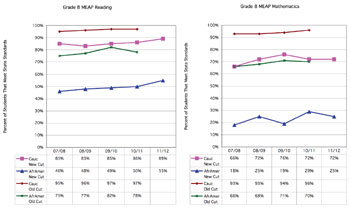
Ann Arbor Public Schools?Grade 5 Michigan Educational Assessment Program (MEAP)?scores for reading (left) and math (right). The green trend lines indicated African American student achievement under the old cut scores. Brown trend lines indicate achievement of caucasians. ?The gap between the achievement has been amplified by new cut scores, which are indicated by blue and purple trend lines for African American and caucasian students, respectively.
Deputy superintendent of instructional services Alesia Flye and director of student accounting and research services Jane Landefeld, presented a comprehensive report on student achievement. While the trustees were pleased and excited to have such a detailed report, and there were several positive points in the data, they also expressed significant frustration at the disparity between the achievement of various subgroups. African American students in the district showed significantly lower achievement on standardized tests than students in other ethnic groups. Trustee Simone Lightfoot described herself as ?fire mad? about some of the results in the report.
The conversation ranged from results and highlights to the challenges the district faces. Flye and her team indicated that the district would continued to work with this data and to implement the district?s established plans to address the achievement gap. But the presentation was a point of information only. [.pdf of AAPS achievement slide presentation with graphs and tables]
Also at the meeting, a proposal for a technology upgrade to the network infrastructure?prompted a conversation about labor contracts. The network upgrade was a first briefing item on which the board did not vote. But conversation about labor contracts continued as trustees heard a second briefing about outsourcing the noon hour supervisor positions. In a 4-3 decision, the board did not approve the a contract with PCMI, which had bid to provide noon hour supervisors at a 24.83% administrative cost.
Student Achievement Report: Overview
The AAPS administration brought a report to the board highlighting student achievement over the past five years. The ?comprehensive, lengthy document? shows how progress was measured and what needs to be tweaked and improved, superintendent Patricia Green said. She stressed that it was not a curriculum report, but rather an outcomes report. An outcomes report will become a yearly tradition, as a way of benchmarking what they the district is doing.
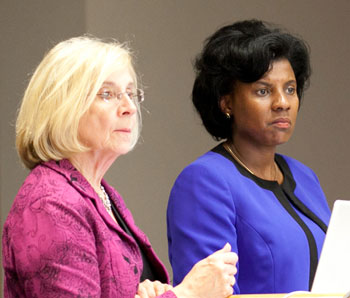
Jane Landefeld, director of student accounting and research services, Alesia Flye, deputy superintendent for instructional services.
The student achievement document is a compilation of data that would?ordinarily? reside in separate files. Green said she wanted to see all the data together ? to have an opportunity to look at all the pieces at the same time. The report has taken a number of months to put together, as data from June 2011 is still being incorporated. According to Green, time is needed to organize that data in a meaningful way. The report was broken into highlights and results for standardized tests, increased rigor for high schools, discipline and suspension data, graduation and attendance rates, and areas of focus.
Flye noted a theme of excellence throughout the report. Several overall student performance highlights were included: The Ann Arbor Preschool was named Best Preschool with Special Needs Services? by Ann Arbor Family publication. AAPS was named a State Academic Champion for excelling in academics with MEAP and ACT scores. Pioneer and Huron high schools were named as among The Best High Schools in America by U.S. News and World Report in May 2012. And Ann Arbor Tech received a Program Award as an outstanding Michigan alternative school.
Flye said that it showed the spectrum of high levels of instruction throughout the district ? from pre-kindergarten to high school programs.
The trustees, along with Green, thanked and congratulated the team that worked on compiling the data. Andy Thomas said that he had been looking forward to a report like this since he joined the board. Now that he has seen it, he looks forward to using the data to drive decisions. Glenn Nelson echoed the appreciation expressed by other board members, and said that he was glad they devoted so much time to talking about it. To him, it demonstrates the passion and the concern the staff and the board have for student achievement. Irene Patalan appreciated that the report was presented early enough in the school year to set the tone for the rest of the year.
Addressing the team that worked on the report, board president Deb Mexicotte said she hoped they felt the excitement that was around the table that evening to discuss the body of work they?d produced. Trustees don?t get to talk about student achievement in depth as often as they would like, because they spend so much of their time doing other business ? like handling the budget and contracts. The trustees would much prefer to be doing the business of student achievement, she said. Despite the frustration they may feel at some of the results, the trustees are excited, energized, and ready to move forward to what comes next. Mexicotte said they knew ?this is the springboard for greater achievement for our students.?
Student Achievement: Testing Results: MEAP
The first test discussed was the Michigan Educational Assessment Program (MEAP). The MEAP is administered to students in grades 3?9. Students in grades 3?8 take reading and mathematics; students in grades 4 and 7 are tested on writing; grades 5 and 8 are given a science test; and students in grades 6 and 9 are administered a social studies test. Students are graded as: advanced proficient; proficient; partially proficient; or not proficient. The results of the test are used to monitor individual student achievement, as well as the performance of individual schools and districts.
The 2011/2012 MEAP data for AAPS compared to the state shows Ann Arbor students performing at higher levels than state average in all areas, at all grades, in all subgroups except for English language learners (ELL). Director of student accounting and research services Jane Landefeld noted that AAPS tests those ELL students when they are not proficient in English. When they are proficient, they are no longer considered ELL students.
The state adopted new cut scores in the fall of 2011, which Flye said were more reflective of career- and college-ready standards. The new cut scores were applied retroactively to the prior years? data so the results could be more accurately compared. Landefeld noted that the change in cut scores impacted the overall proficiency levels. While the test was of the same rigor, the scale was moved up. Scores that were previously judged as advanced proficient are no longer deemed proficient.
Student Achievement: Testing Results: MME
The Michigan Merit Examination (MME) is administered to 11th grade students. It consists of math, science, social studies, reading, and writing evaluations. The MME tests are college-ready assessments. The results of the test were also impacted by new cut scores within the past year. Across the board, reading and writing continue to be the district?s strong suit, with math and science lagging behind. Nearly every subgroup scored above the state average, except for economically disadvantaged, ELL, and Hispanic students.
Nelson hoped that the district computes how many students who don?t not score well on the MME ?? which supposedly would indicate that they would not do well in college ? go on to be outstanding citizens. He said that if students had ?grit? and social and emotional learning, they can succeed. He didn?t want students to be discouraged by test results.
Student Achievement: Testing Results: NWEA
The Northwest Evaluation Association, Measures of Academic Progress (NWEA MAP) test is a computer-adaptive test designed to chart student growth over time, as well as to inform educational decision-making at the classroom level and to evaluate the efficacy of programs. In 2011-2012, the NWEA was administered in September, January, and May for students in grades K?5 and 6?8 at Ann Arbor Open and Scarlett Middle School. In 2012-2013, the kindergarten assessment will be administered only in January and May.
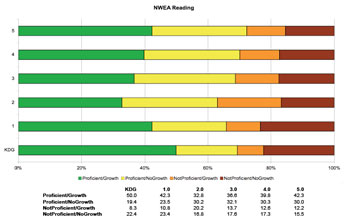
NWEA results on ?slider charts? for grades K-5.
When Nelson asked why the September testing for kindergartners was dropped this year, Green explained that last year, the district saw kindergartners struggle with the stamina required to sit in front of a computer to determine readiness. While she maintained that they wanted as much initial data from students as possible, the experience of NWEA testing proved to be too much for entering kindergartners.
Flye said she has been working with Dawn Linden, assistant superintendent for elementary education, and the elementary principals to bring greater consistency to kindergarten round-up. Along with that consistency, they hope to bring assessment, which would allow teachers to have initial data before students even start school.
Similar to the other test results, AAPS students overall showed results that were roughly at the normative mean for reading. Mathematics saw a similar trend, except for students in 6th and 7th grade.
Thomas noted the students that were classified as ?proficient but not growing,? may be an opportunity for differentiated learning. He saw that as a way of ?biting off? the gifted-and-talented issue. If the district sees students at the top with no room to grow, then ?why not let them go higher?? Green and Flye agreed, with Green saying it feeds right into the strategic plan to provide individualized learning plans. The district doesn?t want to limit students and will work to customize instruction for them.
Some trustees took issue with the way the data for the NWEA was presented ? using ?slider charts.? Several trustees said that was not a helpful tool, and Christine Stead suggested using bar charts to show results better.
Student Achievement: Gaps in Achievement
Simone Lightfoot said she wanted ?to be so wrong? about looking at the data. Just barely half of the African American subgroup met state standards in reading on the MEAP at all grade levels. In math, scores centered around 20-30% of African American students meeting state standards. Data like this, she said, got her ?fire mad.? She was less concerned about beating the state average and more concerned with how AAPS does when compared to similar districts. Flye noted that they have benchmarked the data with other high-performing districts in the tri-county area ? and AAPS is a high-performing district on that comparison, she said.
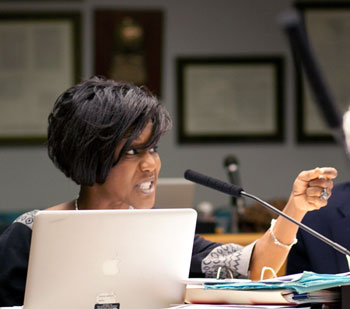
Trustee Simone Lightfoot
Mexicotte shared Lightfoot?s dismay at the lingering disparities in student achievement. She said, however, that if the analysis had gone back more than five years, they would have seen the struggling students performing at an even lower level. The data also shows that for the 2011-2012 school year, while each grade in the district increased reading scores, African American students increased their scores more than the district overall.
Thomas tried to ?pull some gestalt? from the data. His observation was that while there are very significant gaps between various subgroups, it appears that the gap is narrower in the reading section than in math. The data showed him that additional emphasis on efforts in math could yield better results.
Flye recognized that challenges remain. She said that Thomas was right in his characterization ? that there is a narrower gap between reading scores than between math scores for African Americans. More interventions are in place for reading, and the district needs to develop interventions for math, she said.
Landefeld also described the impact of new cut scores that had been put in place. Using the new cut scores, many students who?d previously been analyzed as being on the edge of proficiency now showed up as being not proficient. While the new cut scores impacted all AAPS students, they impacted African American students more, she said. Flye echoed Landefeld?s characterization, saying it was worth repeating. Flye noted that the district is focused on its Achievement Gap Elimination Plan (AGEP), as well as the discipline gap plan.
Nelson said that it wasn?t rocket science to solve the issue. When students are in school, they learn. He would like to see a greater emphasis on early childhood education. If the district could work with students prior to kindergarten, significant gains could be made, and they could be brought up to the same level as other students entering the district in kindergarten.
Student Achievement: Comparisons
Thomas said the overall state data reinforces Lightfoot?s point about not comparing AAPS as a district to the state. At the state level, only 15% of students are proficient in science, which means that 85% of students in Michigan are not proficient. For a state that is trying to advance into the 21st century and become a ?mecca of high tech industry,? those scores are not a good omen, he said.
Nelson described AAPS as ?blowing away? the state standards ?in a relative sense?, especially in reading and writing. The problem, as he sees it, is that high performing groups are really performing well, and but the district hasn?t succeeded in getting all groups to the same level as the high-performing groups. He said that if a student wants to learn math, then AAPS is the place to go. He saw the gap between groups as more a function of high-performing groups doing well, rather than the lower-performing groups not doing well.
Lightfoot just wanted to get through the data, in order to be able to talk about solutions. Countering ?Nelson?s point about AAPS being the place to go to learn math, she said: ?You come to AAPS unless you are African American, Hispanic, economically disadvantaged, or an English language learner.? There were no ways to look at the data to make it more palatable to her, she said.
Nelson agreed with Lightfoot?s feeling of distress around the data, but he said that if they looked at how underserved subgroups in other districts around the state performed, it would be a bad decision to attend school there. Ann Arbor is still outperforming many other districts, even in those subgroups, he said.
Stead also wanted to be able to compare the district?s results to global competition. While the MEAP is a Michigan-only test, the ACT and the SAT could be used to do a comparative analysis with other districts across the country. She was concerned about comparing the district to the rest of Michigan. According to Stead, Michigan has dropped from 18th in the nation to 38th in the nation in education since passage of Proposal A in 1994. She said that AAPS thinks of itself as a national-level district and needs to compare to other nationally-ranked districts.
Trying to offer some broader perspective on the report, Mexicotte said that the benefit of having all the data in one place, and being able to see growth year-to-year, is being to understand exactly what kind of work needs to be done over the next year. The data shows areas of great concern and great celebration, she said. She acknowledged, however, that each trustee would see the information through a different lens.
Student Achievement: Looking at Patterns
Green noted that patterns emerge in the data. In the sixth-grade MEAP data for the 2011-2012 school year, African American student scores dropped, while in other grades, scores have increased over the past five years. What happens between 5th and 6th grade for African American students? Green?s experience tells her there needs to be more attention paid to what happens to students in their sixth grade year.
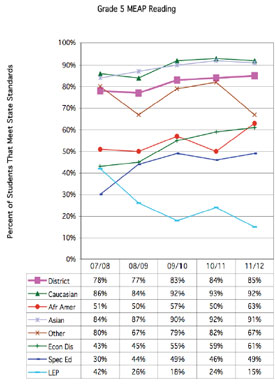
MEAP Reading Grade 5. The red trend line reflects achievement of African American Students ? an improvement in the last year.
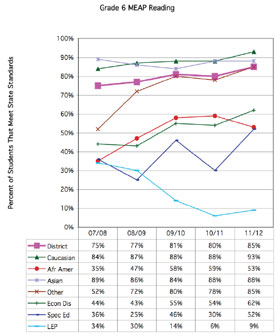
MEAP Reading Grade 6.?The red trend line reflects achievement of African American Students ? an improving trend that dipped in the last year.
Because the MEAP testing is done in early October, Thomas said, the testing ultimately reflects what was learned the previous year. So for the example of the dip in 6th grade testing results, it is a reflection of the 5th grade level, he said.
Green said that it reflects something about how 5th and 6th grade were linked together for that subgroup of students. They need to look more closely at what kinds of interventions, if any, are taking place.
Nelson ventured that there was greater student turnover ? students entering and leaving the district ? at the 6th grade level. The change in student body composition could conceivably have an impact on test scores at that grade, he said. He wondered if there was some way to see if the data reflected that kind of change of student body.
Lightfoot asked if the same kind of transitional challenges were seen when 6th graders remained at the elementary school level, instead of transitioning to middle school. Green said there were many different theories on which method was the best. She said the key was making those students feel like they belong, whether they?re in elementary school or middle school. She did note that her recommendation would be for a K-8 model.
Student Achievement: Role of Testing
The trustees talked over the role of testing. They acknowledged they?d been hearing from the public about the amount of standardized testing done in school. [For example, a Facebook group has been established: Ann Arbor STOP ? Stop Overtesting Our Pupils]
Thomas said that the board?s conversation and the report has been an excellent example of how the MEAP is looking in the ?rearview mirror? at district performance. It highlights the need for current-year assessments, like the NWEA. Thomas acknowledged the pushback from the community over the NWEA, but he said the usefulness of the MEAP data is limited. NWEA provides data over the course of the year, he said.
Green?described?the MEAP as not an individual student test, but as a way to judge the school and the district as a whole. The NWEA is specific to each student and allows teachers to personalize and develop individualized learning plans, one of the district?s strategic goals. Green said that even if it was through the rearview mirror, the MEAP results helps the district to recognize trends. Mexicotte said it was akin to using the right tool for the job. Patalan noted that the MEAP allows the district to see patterns, which allows for correction to negative patterns.
Flye reported that teachers in the field have said they appreciate the immediate feedback from the NWEA. It helps inform instruction in the classroom.
When Lightfoot asked if there were any tests that could be?eliminated?because the district uses the NWEA, Flye responded that the issue was being examined. Currently, the state assessments [MEAP, MME] are required. She suggested that maybe the district didn?t need to administer as many cycles of the test, or administer it to so many grade levels. The district is still in the process of determining the correct route, Flye said.
Susan Baskett asked about the ramifications of having students opt out of the NWEA testing. She wondered if a student?s academic career could be jeopardized by not testing, especially if the NWEA is so instrumental in targeting individualized needs for students. Flye described the test as a tool for systemic planning, and they?ve seen more value from the NWEA than from the state assessments.
Student Achievement: Increase in Rigor
Thomas noted that at the same time the state is reducing funding for K-12 education, the state is showing three-quarters of students not proficient in science. He wondered if those who control the resources see this as a crisis. Or do they see it as ?we need more ditch diggers,? he asked. Green characterized the state?s perspective as wanting to add more rigor ? which is why the cut scores have been changed. Part of the issue for Green is that it?s not clear to her what benchmarks the state is using to measure the district. Several different methods are used to talk about gaps ? from state averages to the Focus School designations.
When the state keeps changing the playing field, Green said, it is difficult to benchmark what is actually being done in schools. So the district has to stay focused on what the community values and make sure that all students have a rigorous curriculum. The district needs to identify what its expectations are of students, and work towards that.
Mexicotte said that when the state defines the crisis as ?rigor,? then it becomes the fault of the district. But the real crisis is at the state funding level and an underfunding of public education, she said. When she hears ?rigor,? she hears it as blame being laid at the feet of the school districts.
Stead made the point that the underfunding of public education was exacerbated under the current state administration. According to Stead, $1.7 billion in declining revenue was made up for by a $1.1 billion cut to public education. The lack of funding goes beyond Proposal A, and is unique to the current administration, she said.
Student Achievement: Suspension and Discipline
Flye said that since implementing the discipline gap plan, the focus has been on social and emotional learning of students. To do that, cooperative discipline has been implemented across the district with monthly monitoring. As a result, Landefeld said, the number of students suspended within the past year has been reduced. Progress has been made across the board ? from the elementary to the high school levels.
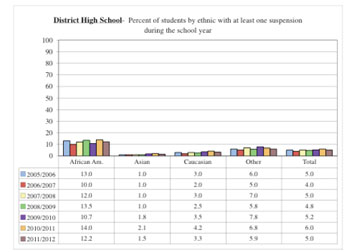
AAPS high school suspensions by ethnic group by year.
When Lightfoot asked for an explanation in the decrease in suspensions, Flye said the key was examining the data on a regular basis. She said staff at the building level are having monthly conversations about the social and emotional growth of their students. Green mentioned that when the discipline gap plan was released in Dec. 2011, there was a significant conversation about subordination, what defiance means, and how the focus has changed. Social and emotional development was crucial, she asserted. ?That?s why the district brought in?James Comer, an expert in child development, the week of Oct. 15, to speak to various members of the district.
Thomas and Lightfoot asked if there was a correlation between attendance and the changes in transportation made last year. For the 2011-2012 school year, they noted, changes were made in bussing and walking distances for students, and the board would be debating more changes to transportation service in the future. Landefeld said that to be able to determine that correlation, more years of data would be needed. Lightfoot stressed the ?need to talk to students,? because they?ll know best.
When students aren?t in school, Green pointed out, they can?t be taught. She said they were looking at what behaviors can be shifted, so students can be in school.
Student Achievement: Role of Truancy, Homelessness
Lightfoot asked that Derrick Padgett, the district?s sole truant officer, be part of the discussion about achievement. Noting that mental health is one of the top issues faced by chronically truant students, she asked about the correlation between single-parent households and mental health. Padgett explained that in his work, he sees a correlation between students having anxiety and single parent households. He noted that if busing were discontinued, students in subsidized housing could face problems getting to school.
Lightfoot asked Padgett if there was anything the board needed to know, to help support him in his job. Padgett responded by saying that it?s important to work as a community, using all resources for helping students. He asked that the district stay on top of changes to state law. He noted that if the children of welfare recipients are not attending school, welfare benefits could be cut off. It is important to make parents aware of this consequence, he said.
Baskett asked how serious an issue truancy is in the district. Padgett responded that two years ago, the district did not employ a truancy officer, and truancy was not considered to be an issue. Now the focus is on the possible connection between mental health and truancy.
Baskett requested that if Padgett identified any issues the board could control, to let trustees know ? because they would like to make sure they are doing right by the students. She realized his job is evolving, she said, and new things come up.
Flye mentioned one of the action items implemented this year was creation of a curriculum senate. The senate?s main focus is to bring all the key leaders together around one table to have conversations about addressing the needs of the whole child. Both Padgett and Azibo Stevens, district homeless liaison, is part of the senate. She also noted that the counseling department is now part of the instructional division, which was a previously missing important part of the puzzle.
Stead expressed shock that there were over 200 students in the district in the 2011-2012 school year that were classified as homeless. Stevens said that while 246 students received services under the federal McKinney-Vento Act, they expected to see even more?because?the district is working to improve identification rates.
Asked for his advice on policy or support, Stevens suggested that the board work to galvanize the community. More volunteers to mentor unaccompanied youth were needed. He said the students have a commitment to being in school, but they don?t have the guidance they need.
Student Achievement: Moving Forward
As the district moves forward, Flye said there will be an increased focus on developing personal curriculum. District staff will continue to work with data teams. She noted that sometimes data is?surprising?when it contradicts what everyone already?believes ??so training on DataDirector will be important for providing immediate information for teachers. Flye also noted that the AGEP and the discipline gap action plans will be continue to be implemented.
Outcome: This was an informational report, which will be updated yearly. No board action was required.
Tech Infrastructure Replacement
The board heard a presentation on the first very large purchase using the tech bond money ?? a district-wide replacement of the network and wireless infrastructure, costing $5,192,872. This work is an essential component to upgrading the district?s technology, according to Green. ?It includes cabling work and projector installation.?The work will be completed?in the course of 2013 and 2014, with a target end date in fall 2014.
Bids for the work were advertised on the state bid website and in the local newspaper, in addition to contacting known interested bidders. Four bids were received. A project team of Barton Malow and Ann Arbor Public Schools ITD staff conducted post-bid interviews with multiple bidders. As a result of those interviews, Sentinel Technologies was recommended for the contract award.
Executive director of physical properties Randy Trent outlined the proposal. When Thomas asked for an overview of the upgrade, Trent explained it was for switches to increase bandwidth. He said some of the equipment currently in schools right now was as old as 15 years. The hardware that will replace it will be the newest equipment available.
Outcome: This was a first briefing. The board will vote after a second briefing at the next regular meeting.
Contract Process Conversation
The conversation turned from the actual technology equipment that would be installed to the bidding process. Baskett wanted to know why the recommendation was for a company that was based in Illinois, as opposed to the company with the lowest bid, based out of Grand Rapids. Trent explained that ISI, the Grand Rapids company, provided an incomplete bid. The district pursued getting a more complete bid from the company, without success, he said. Sentinel Technologies has a satellite office in Ann Arbor and employs workers who ?live within an hour drive,? said Trent.
Baskett pressed further, asking why none of the companies indicated if they were a minority or women business enterprise. Lightfoot echoed Baskett?s question, saying she had trouble with the district?s professed commitment to certain things, but not reflecting that commitment in awarded contracts. She asked when the best time would be to have a conversation about the district?s commitment to minority-owned and locally-owned businesses. She?indicated?that might allay her own frustration and that of others.
Stead mentioned that just over a year ago, the planning committee spent about seven sessions talking over the topic. A reception had been held by a vendor to encourage minority-owned businesses to bid. She said that it might warrant a policy change, if the board wants to make it part of the requirement for contract bidding. Stead said the board needs to look at the law to see how it coincides with the lowest qualified bidder requirement ? saying she wasn?t sure if anything else could be added on to that requirement.
However, Thomas questioned the necessity of continuing with a particular hiring initiative, saying it would take a lot to convince him to go with anything beyond lowest qualified bidder. To him, things have changed considerably since the days of the ?good-old-boy network? of the ?60s and ?70s. He said the bid process is now much more transparent, because all bids must be submitted through the website. Anyone who wants to submit a bid can do that, he said. He said he wasn?t aware of anyone who felt they?d been prevented from bidding on a project.
Responding to Thomas, Lightfoot contended the good-old-boy network was alive and well. She was troubled that the district asks the community for support, then goes with the lowest bidder when it comes to awarding contracts, regardless of whether the bids are from local companies.
Baskett agreed with Lightfoot, and said she didn?t believe Thomas had all the information needed to make an informed decision. To her, it was ?not a matter of the lowest anything, but the best qualified of everything.? ?According to Baskett,?40?50% percent of local electrical workers are unemployed. Because part of the district?s educational program is career and tech ed, she believes that the district has a responsibility to allow those students to be gainfully employed. As resources become more constrained, she argued, they need every dollar at the table. If there is anything that could be done within the limites of the law and ethics, she believes it should be done.
Nelson weighed in, saying that for him, the district?s mission is to educate students to the best of its ability. They must get the biggest bang for their buck. He said people are most concerned that the board will be good stewards of their money ? which he?d had reinforced from the tech bond millage campaign.
Patalan said she was willing to trust Trent and his professional team when it came to doing due diligence in getting the lowest qualified bid. She agreed with Thomas in his contention that there is more transparency in the process now. Ideally, she would like to be able to do both things: be fiscally responsible and use local workers when possible.
Both Baskett and Lightfoot argued for having the discussion. Baskett pointed out that the board hadn?t yet received a performance report on the contractors. The lowest qualified bid doesn?t preclude locally- or minority-owned businesses, she maintained. She would like to put the discussion on the table to better understand the complications, because the support of everyone in the community is needed. Lightfoot argued for getting clarity on the board?s commitment to fairness and equity. She said having the discussion would help clarify that. She pushed for honesty in the board?s words and deeds.
Mexicotte noted that in the past, the board has had conversations about contracting and consultancy. She specifically referred to the board?s work on the Comprehensive School Improvement Plan (CSIP) [in 2007]. She recalled that the trustees talked about how they defined items such as ?local? versus ?southeast Michigan.? That conversation, however, was held at a different time by a different board. Mexicotte ventured that now might be a good time to look at the district?s policies and procedures on contracting, especially since the topic arises often. Her suggestion was to have that conversation at a committee of the whole (COTW) meeting. She said she liked to put things to rest, and she recognized trustees have had this conversation several times, but no one ?is getting any rest.? In consultation with Green, Mexicotte would look at the board?s calendar and determine when to schedule something.
Baskett appreciated Mexicotte?s desire to put the issue to rest. In her opinion, it would be best to have an hour or two conversation on the topic and come to an agreement. Stead indicated a?preference?to prioritize student achievement and semesters versus trimesters at the high school level ? over contracting policy. Lightfoot asked that contracting policy not be pushed too far into the future. Because some large contracts are coming up, she doesn?t want it to be the case that ?all the contracts are awarded before a contracting policy is established.
Noon Hour Supervision: Rejected
The board was asked to approve a contract with Professional Contract Management, Inc (PCMI) to provide noon hour supervisors to the district. The contract was?recommended by deputy superintendent for operations Robert Allen as a cost savings measure. Contracting with PCMI is an alternative to having AAPS employees provide the supervision. The board had been briefed on the item at its Sept. 19, 2012 meeting. At the meeting, Green introduced the topic to the board as a second briefing item, saying it had its genesis in budget reductions this past year. PCMI?s bid was the only one was received by the district. Green acknowledged that the proposal did not come in at the percentage they had hoped for.
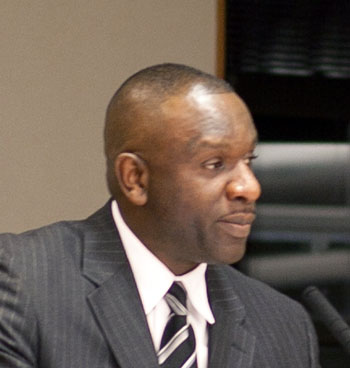
AAPS deputy superintendent for operations Robert Allen
PCMI?s original bid was to charge the district 25.83% of the gross wages to be paid to the supervisors themselves. When several trustees at the board?s first briefing expressed dismay?at the high administrative charge, Allen negotiated for a one percentage point decrease ? to 24.83%. That one percentage point drop would translate into an additional $6,000 to $7,000 per year savings, for a total of $61,000 to $62,000 in savings. Allen noted that PCMI?s rate includes 7.5% for FICA, so PCMI?s take-home administrative fee is closer to 17.33%.
Lightfoot asked if Allen had talked with any of the noon hour supervisors who would be impacted by the shift to PCMI. She encouraged him to have conversations with the employees going forward. Allen said that while the supervisors were not represented by any particular union or leadership, he had spoken to some groups of long-term employees. Their main concern was about possible impact to their wages. Allen verified with PCMI that there would be no change in wages. There was also an interest in current employees being given right-of-first-refusal ? meaning they would be offered jobs with PCMI before any new hires were made. Allen reported that right-of-first-refusal would be incorporated into the proposal.
The savings to the district from contracting with PCMI would come from the elimination of payments into the Michigan Public School Employees Retirement System (MPSERS) ? for employees who would most likely not take advantage of the pension system. Because an employee must work 1,000 hours per year to qualify for the program, ?noon hour supervisors do not typically work enough hours to be vested in the system. The district, however, still pays into MPSERS for those employees.
Mexicotte said she had been thinking a lot about this contract since the board?s last discussion on the topic. While she understood that the district was trying to save money, she was fundamentally opposed to taking on a multi-year contract with an exorbitant administrative fee. She would rather take the public?s money and give it to MPSERS, a system that at least supports public employees. It was also troubling to her that it was such a seller?s market ? because ?there were so many other districts looking to save in any way they could. Even though the board has cut budget items to achieve even less than this amount of savings, Mexicotte said she was ?very reluctantly? not in support of outsourcing the noon hour supervisors.
Baskett and Stead were both concerned about the non-competitiveness of the bid ? as there was only one response to the RFP. Stead said that without another competitive bid, the argument was not as compelling. She would prefer to consider these kinds of proposals in the context of putting the budget together. Without that context, Stead said, it didn?t translate into the same real help for students. Baskett wondered if PCMI would drop another percentage point, if pressed. Lightfoot said she always struggles with outsourcing or privatizing, as it goes against her principles. She asked Allen to ?push harder and be meaner? in negotiations with PCMI.
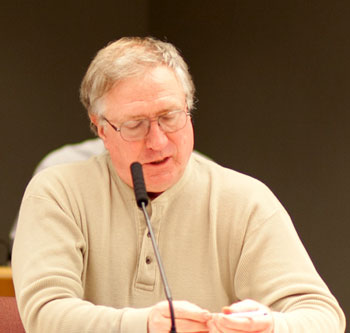
AAPS trustee Andy Thomas
Thomas said that while he shared sympathy for the opinions expressed by Stead and Mexicotte, he believed they needed to ?glom onto any opportunity? to save money. To him, it was a win-win situation: ?The district pays less money, PCMI gets money, and employees and students are not disadvantaged in any way. Nelson noted that not only does the proposal not harm the students, but it helps them ? to the tune of approximately $61,000. As Mexicotte noted, the board has made cuts for less savings than the district would see by contracting with PCMI. Thomas said he was ?not willing to put hubris above economic realities.?
Patalan sided with Thomas and Nelson, saying that ultimately, it comes down to the budget. While the bid itself doesn?t feel right to her, $61,000 is a lot money to save, she said.
Mexicotte said she was willing to accept it was hubris, but also recognized that in the past, when the board had made cuts to save smaller amounts, 100% of the money flowed back into the district. That would not be the case, if the board were to accept PCMI?s proposal, she contended.
Outcome: After the noon hour supervision contract was moved from the consent agenda to a board action item, the proposal failed to be approved on a 3-4 vote. Voting for it were Thomas, Nelson and Patalan.
Sexual Health Program: Approved
The trustees were given a second briefing on two recommended sexual health programs. One is designed for preschool through 2nd graders. The other is a 15-minute video about puberty designed for 5th through 8th graders.
The program for younger children ? preschool through 2nd grade ? is called Body Safety Training. A sample lesson provided in the board packet highlights the concept of ?Boss of Body? ? e.g. ?Who?s the boss of your body?? ?Me!? The lesson focus on teaching children a ?Body Safety Rule? which they apply to decide if certain touches of their private parts are okay.
The program for the slightly older children ? 5th through 8th grade ? was updated in 2011. According to the staff memo in the board?s information packet, that makes the video more recent than any puberty video that has been previously approved by the board. The district?s Sexual Health Education Advisory Committee (SHEAC) described the video in positive, but not entirely uncritical terms: ?The video used relatable teens but the dialogue was a bit ?cheesy? and I think youth will pick up on that. ? I appreciate how the video points out the positive side of puberty. ? Information is clear. It?s presented well even if it is a little stilted at times. It?s much better than most I?ve seen.?
The trustees were appreciative of SHEAC?s work. Nelson said he was especially impressed with the quality of work. Patalan said that while she was not at the first briefing, she knows the students are in good hands with the committee. She acknowledged how important it was to teach young students because they absorb so much, and the sexual health curriculum is part of learning about life.
No member of the public spoke at either of the two required public hearings ? the first held at the Sept. 19 board meeting and the second at the Oct. 10 meeting. Members of SHEAC were on hand to answer any questions asked.
Outcome: The board unanimously approved the SHEAC recommendations as part of the consent agenda.
Seat Time Waiver: Approved
The board was asked to approve the district?s seat time waiver application. While the district?s seat time waiver program has been operating since 2007 as the Options Magnet program, this is the first year board of education approval was required. The state has indicated that if the board approves, then the state has approved.
A seat time waiver allows schools to count and receive funding for students who take more than two non-traditional classes ? online or community resource ? if they follow the requirements set by the program. The program serves a range of students: from previously home-schooled students to students who are looking to develop their own individualized educational plans.
Outcome: The board approved the seat time waiver as part of the consent agenda ? having already discussed the item when they were first briefed at the Sept. 19, 2012?meeting.
Communications and Comment
Board meetings include a number of agenda slots when trustees can highlight issues they feel are important, including ?items from the board? and ?agenda planning.? Every meeting typically includes public commentary on subjects not necessarily on the formal agenda or that are not covered elsewhere in The Chronicle?s meeting report.
Comm/Comm: Calculus of a Principal Hire
During public commentary at the start of the meeting, Pioneer High School math teacher Michelle Macke noted she had addressed the board its previous meeting a few weeks ago. She?d been trying to get the hiring process moving along for the open position of principal at Pioneer High School. [Kevin Hudson, who was assistant principal at the school, has been serving as interim principal since July 2012, when Michael White left the district.] She noted that the job has now been reposted. AAPS director of communications Liz Margolis had sent a note to Pioneer staff on behalf of superintendent Patricia Green, saying she felt there was a need to widen the applicant pool.?Candidates previously considered, she continued, were still in the pool, according to the note. On Oct. 16 the interview process would be re-started.
Because Kevin Hudson had been moved up to interim building principal, Macke reported, that had vacated an assistant principal position. And that position had been filled with a math teacher ? Robert Klemmer. Because the math department believed the arrangement would be temporary, a substitute was hired. In order to provide adequate calculus instruction ? which Klemmer had taught ? on Sept 28, more than 300 Pioneer students got a new math teacher. The schedules needed to be shuffled, because none of the 30 substitute teachers felt they could step in and teach calculus. So other Pioneer teachers took on the calculus classes, but that meant that other math classes were transfered to the long-term substitute. students. Kids have have a lot of extra anxiety about math, she said, and the situation is unacceptable to her as a math teacher and as a parent. She hated to say it in front of teenagers, but they?re prone to making excuses for not doing well, and this is another excuse they?ll use. She wanted to speak up for the 300 kids whose math teacher was changed.
Comm/Comm: Trimesters versus Semesters
During public commentary at the start of the board meeting, Alice Morgan introduced herself as the parent of three students in the district ? a junior and freshman at Skyline High School and a 6th-grader at Forsythe Elementary. She and her husband have lived in Ann Arbor for 20 years and own Satchell?s BBQ restaurant. She?s become increasingly concerned about the trimester system at Skyline. She wanted to focus on three main problems, two of which she called self-evident.
The first problem with trimesters is learning loss. Skyline students take courses in math, English and languages for just two out of three trimesters. That results a three and a half month gap in math or English during the year. And in extreme cases ? from one year to the next, can result in nine-month gap. Such a nine-month gap could result from taking math in trimesters one and two of a school year, then taking math in trimesters two and three of the next year. As she?s talked with prospective Skyline parents, she?s found that this is seen as an impediment to enrolling children at Skyline. She herself sees a problem with her own daughter?s experience ? because she?s is prepping for the ACT and she?s not taking math right now.
The second self-evident issue is that Skyline?s calendar is out of sync with the rest of the of district. That means that Skyline students can?t easily take classes at other high schools in the district, and vice versa. Other scheduling challenges arrise from the need to try out of spring sports in the middle of their exams. It doesn?t make sense that Skyline is different ? and it results in a profoundly different educational experience with a trimester system.
The third and biggest problem, she said is that it?s a ?scheduling nightmare.? It results in lots of student having to take core classes online, because it?s not offered in the right trimester. Students might not want to take the course online ? and they want to be in class with teachers and with their peers ? but they?re forced to take the classes online due to the scheduling constraints of the trimester system. Advanced placement (AP) classes are constrained by scheduling problems. ?It just doesn?t work,? she said.
Comm/Comm: COTW Update
As an update to the Oct. 3, 2012 COTW meeting, at which the board discussed its financial goals, Mexicotte handed out a summary document to the trustees. Working to amend Proposal A, a countywide enhancement millage, and increasing and maintaining enrollment were several of the ideas discussed and given actionable steps by the board.
Mexicotte had organized the document into three sections ? the questions trustees discussed, their commentary, and action steps ? so they could remember what they were thinking as they work through these items over the next year. She thanked the trustees for starting to lay the groundwork, as some movement had already been made on many of the items they had talked about. Mexicotte said she wanted to call the public?s attention to the document [which will be made public after the board approves it].
Comm/Comm: Executive Session Approved
The trustees unanimously approved an executive session of the board to be held on Oct. 24, 2012 at 5:30 p.m, directly before the regular meeting at 7 p.m. At the executive session, they will receive and discuss with legal counsel a legal opinion protected by the attorney client privilege requested by the superintendent and provided by legal counsel.
Comm/Comm: Student Reinstatement Action
Following an earlier committee conversation, Student A was unanimously reinstated, eligible to return to school on Oct. 25. Lightfoot clarified the recommendation that was laid out during the committee process time had been adhered to.
Comm/Comm: MASB Delegates Selected
Four of the trustees ? Baskett, Lightfoot, Patalan, and Stead ? volunteered as delegates to the Michigan Association of School boards (MASB) Delegate Assembly. At the assembly, set to begin Thursday, Nov. 8, delegates selected by boards of education across the state will decide MASB?s positions on a wide variety of issues affecting education ? including their position on proposed legislation being considered by the State board of Education. Nelson was identified as an alternate.
Present: President Deb Mexicotte, vice president Christine Stead, secretary Andy Thomas, treasurer Irene Patalan, and trustees Susan Baskett, Simone Lightfoot, and Glenn Nelson.
Next regular meeting: Wednesday, Oct. 24, 2012, at 7 p.m. at the fourth-floor boardroom of the Ann Arbor District Library?s downtown branch, 343 S. Fifth Ave. [Confirm time, date and location]
The Chronicle could not survive without regular?voluntary subscriptions to support our coverage of public bodies like the Ann Arbor public school board. Click this link for details: Subscribe to The Chronicle. And if you?re already supporting us, please educate your friends, neighbors and colleagues about the importance of helping to support The Chronicle, too!
denver weather planned parenthood what time does the superbowl start kobayashi roseanne barr margaret sanger paul george
No comments:
Post a Comment
Note: Only a member of this blog may post a comment.